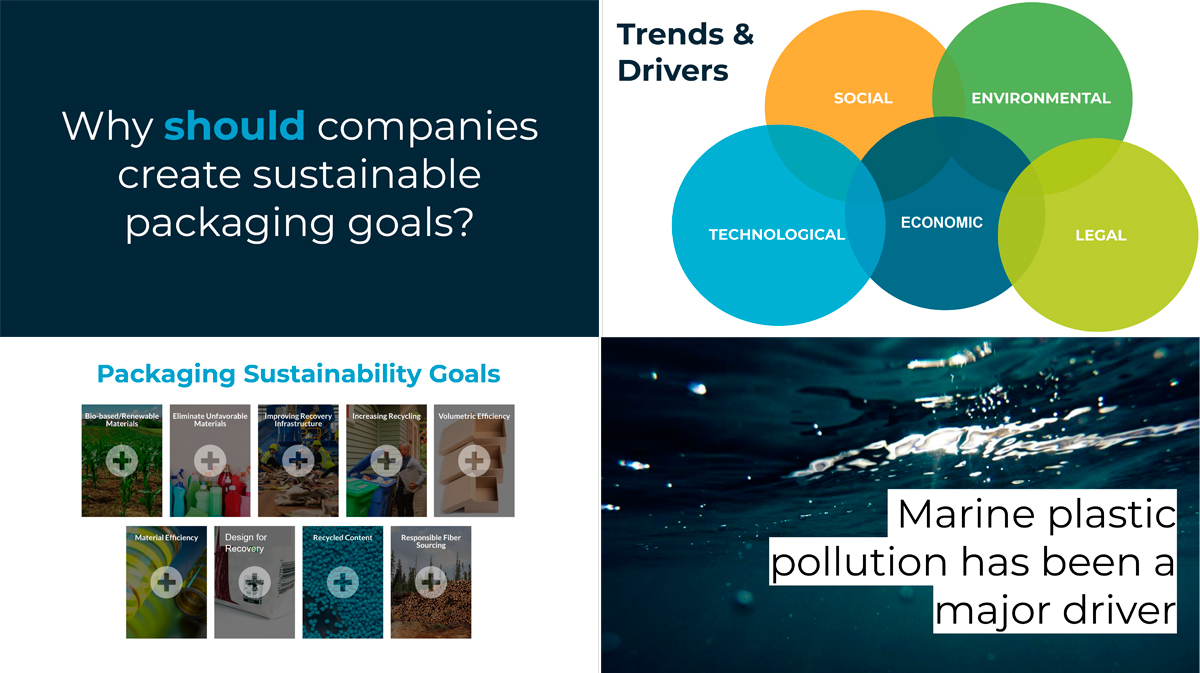Sustainable Packaging Coalition Takeaways
Event - SPC Engage: Minneapolis
The Sustainable Packaging Coalition (SPC) is a membership-based collaborative that believes in the power of industry to make packaging more sustainable. The all-day event, SPC Engage: Minneapolis, was created to “promote solutions and catalyze action “ by attendees by “activating corporate sustainability goals.”
The day
The event was full of diverse and interested businesses, from major food and beverage brands, to health and wellness start-ups, recycling facilities, sustainable environmental organizations, and us. The surprising assortment of attendees and clear category authorities demonstrated the universal desire to move the dial in the direction of sustainability.
A sample of presentation slides from the day.
Two moderated panels answered questions about Responsibly Sourcing Materials in Packaging, and Designing Packaging Holistically. Professionals from Caribou Coffee, General Mills, PepsiCo, NatureWorks , Eureka Recycling and others brought their perspective and expertise to the salon style discussion.
Takeaways
The Circular Economy
For years we've lived in a linear economy. Most products were created and produced, used and discarded, with little thought or effort into what happens at their “end of life,” how they are disposed. Now packaging companies, businesses, recovery centers (composters, recyclers) and material suppliers are shifting efforts to reflect a circular economy. This revolves around the idea that what goes in must come out and make the world better, or re-enter the system again, to live another “life,” thus eliminating as much pollution as possible. This means considering a product’s end of life from the very beginning and designing against any waste.
The circular economy or “circularity”
Designs out waste and pollution
Keeps products and materials in use
Regenerates natural systems
Image via the Ellen Macarthur Foundation
The Fourth R – Recovery
Reduce, reuse, recycle has been around for a long time, but recovery, to gather materials from waste, or use waste to create energy, is a newer and lesser known component. Recovery is used manage residual waste (after the other 3 Rs have been completed) to meet zero-landfill goals. Depending on the type of waste, this can come to light in a variety of ways, i.e. diverting food waste from a landfill to create energy, fuel, or other nutrients.
Waste hierarchy from Energy Justice Network.
Waste recovery facility in Leeds, UK.
We can all do better
As of 2015 (the most recent data collected by the EPA) only 34% of the municipal solid waste generated is recycled or composted. This number is steadily increasing but the opportunity for more business and consumer education, opportunities, and effort centered around recycling and composting would be hugely beneficial. Many companies don’t understand the implications of their choices and how the creation of certain plastic products, although recyclable, don’t have any after-market value, thus can’t be sold back into the circular economy, once recycled. Many consumers, who are pressed for time or enter decision paralysis when faced with waste disposal options, don’t realize the importance of scraping their compostable plate, or have enough prior experience to place their waste in the appropriate bins. This drives up the cost for the materials recovery facilities making the end product more expensive and therefore less competitive. Smart design from the start, broader public education, and engaging with evolving consumer values, could solve a lot of these challenges.
About the Sustainability Series
This content is a part of the Ultra Sustainability Series. Through education, field trips and resource utilization, Ultra aims to be more fluent in the conversation around sustainability, particularly as it relates to package design. Each month, we’ll feature a topic relating to this with hopes it helps continue the conversation in the industry.







